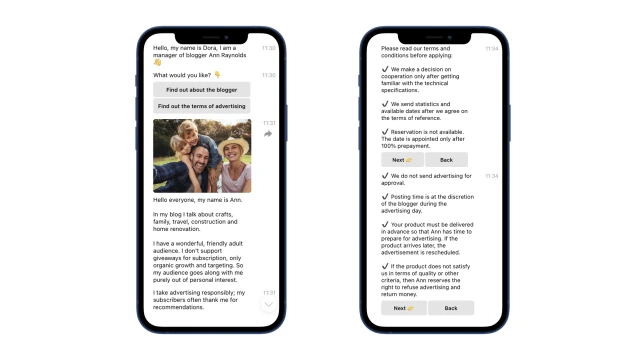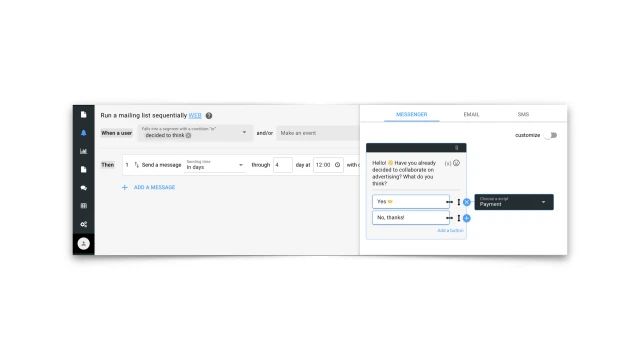
Blogger manager
The bot helps coordinate and place advertising.


You need to log in to see the interactive example.


You need to log in to see the interactive example
Copyright protection from copying
Communication with potential advertisers requires a lot of time and attention from a blogger. We have created a bot that will help manage advertising placement:
1. Weed out inappropriate advertisers
2. Receive technical specifications
3. Send statistics
4. Make payment
5. Send message chains depending on work status
6. Collect feedback on cooperation
The bot itself forms a client base in a table format, which is convenient to work with in the designer. You only need to change the work status and join the process as needed.
Difficulty level: medium-difficult — you need to understand the configuration of the “Table” and “Router” blocks.
Setup time: 3-4 hours (depending on the bot script).
Versatility: suitable for working with a client base as a CRM system.
How does it work?
The user launches the bot on Telegram using a link. The digital assistant meets and introduces him to the blogger, the product and the terms of advertising.

Next, the bot finds out information about the potential advertiser and, depending on the answers, sends a script. If the topic is suitable, it requests technical specifications for approval; if the blogger does not advertise such products, the bot ends the dialogue.

At the same time, the bot creates a table with a customer database, where it saves information about the user and files (TDA). You manage the “Status” column yourself: change work statuses and create a separate script for each (coordinating advertising, accepting payments, collecting feedback, etc.).

Depending on the status, the bot launches the appropriate script. For example, with the status “Agreed”, it sends a notification to Telegram and start a chain of messages: it talks about the terms of placement, sends statistics, asks about the advertiser’s decision and, if the answer is positive, provides payment details and saves the receipt to the client database.
After each change of work status in the table, the digital assistant automatically sends corresponding messages. Thus, the table works like a CRM system.

You can add other statuses to the table and then supplement the settings in the “Reaction to status changes” script following the example of already configured blocks. The essence of this mechanic is that the bot monitors the “Status” (“H”) column in the table; when the status changes, the bot looks for it in the “Router” block and sends the script along the appropriate line.

The bot can also send reminders at scheduled times. For example, in 4 days after the first contact with advertisers, the bot reminds those who have not yet decided to place ads about cooperation.

What to do with the template?
1. Create a project in the designer and add this template. 6 scripts and a table will appear in your project.
2. Edit the script.
3. If necessary, adjust the contents of the table. Don’t forget to correct saving data to a table in scripts (“Table” block).
4. Connect Telegram in the “Settings” section.
5. Test the bot.
If you have any questions about setting it up yourself, contact our Telegram community.
 Talpha
Talpha

